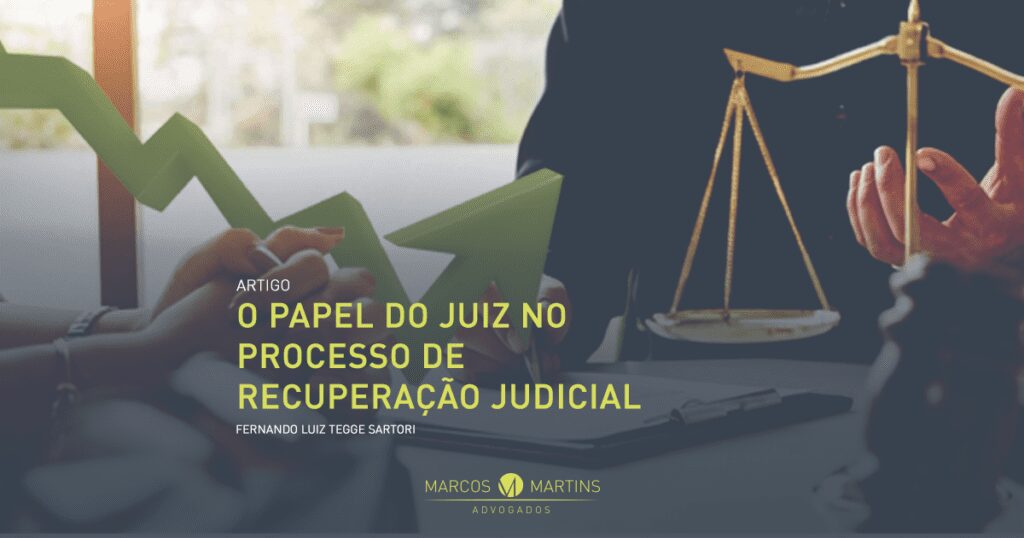Fernando Luiz Tegge Sartori
Lawyer at Marcos Martins Advogados

The judicial reorganization process is a legal alternative for companies going through difficult times, which have been unsuccessful in restructuring the company through out-of-court negotiations and administrative measures, aimed at collective negotiation and supervised by the judiciary in order to restructure the company.
This restructuring of the company, by means of Judicial Reorganization, requires the company to meet a series of requirements in order for its request to be granted by the court hearing the case, especially with compliance with the requirements of articles 48[1] and 51[2], both of Law 11.101/2005.
Once the requirements of articles 48 and 51 of law 11.101/2005 have been met, the judge will grant the processing of the Judicial Reorganization, under the terms of article 51 of law 11.101/2005[3].
The procedural sequence indicates that the debtor will present its judicial reorganization plan (art. 53 of Law 11.101/2005[4]), which will be put to the creditors at a General Meeting of Creditors (art. 35[5] et seq.) and, if approved (art. 42[6]), will be submitted to the court in which the case is pending for legality control and subsequent approval of the JRP (art. 58[7]). Once the JRP has been approved, the debtor will remain in judicial reorganization for a period of 2 years (art. 61[8]) or until the case is closed, if it exceeds the period indicated in the law.
However, throughout this procedure, what is the role of the judge in the Judicial Reorganization process? Should he only observe compliance with the legal requirements or should he interfere in all acts of the process, including negotiations?
Could he, for example, receive an initial petition, instructed with all the proof of compliance with art. 48 and documentation of art. 51 and, based on his free will, reject the request for Judicial Recovery with judgment on the merits?
On this point, it seems to us that the judiciary’s role in the Judicial Reorganization process should be to supervise the procedural debates, ensuring compliance with Law 11.101/2005, both in terms of the deadlines indicated in the law and the requirements listed therein.
Judicial reorganization is a contest of creditors, a meeting of all creditors in a single process and at the debtor’s own request, which in itself demonstrates the debtor’s willingness to negotiate, resolve its pending issues and restructure itself to overcome the crisis it is experiencing.
The judicial reorganization plan itself is in the nature of a contract, and therefore a negotiation between the parties to the process. The purpose of the law is precisely this: to provide the parties with collective bargaining, under the supervision of the judiciary and with the aim of overcoming the petitioning debtor’s crisis.
Therefore, a judge should not reject a request for judicial reorganization from a company that has met all the requirements set out in articles 48 and 51 of Law 11.101/2005, on his own judgment, without having carried out an expert opinion, without having requested clarifications and/or supplementary documents and without having relied on technical assistance to deny a request for Judicial Reorganization.
In this sense, statement 46 of the 1st Commercial Law Conference:
It is not up to the judge to fail to grant the judicial reorganization or to homologate the extrajudicial one based on the economic-financial analysis of the reorganization plan approved by the creditors.
The legislation itself indicates the objectivity with which the judge must analyze the request, since article 52 states that “If the documentation required in article 51 of this Law is in order, the judge shall grant the processing of the judicial reorganization”.
In this sense, it can be seen that many technically bankrupt companies, if subjected to a cold analysis of their balance sheet or cash flow, have had successful judicial recoveries, since the safe business environment provided by the process has allowed the sale of operating units, with the consequent preservation of business activity and jobs.
Likewise, with regard to the various procedural discussions, it is argued that the judge should respect the negotiation that takes place in the process and manifest himself especially when provoked by the parties, especially to judge controversial cases, discussions relating to credits or, ex officio, if he finds any illegality brought by the parties to the process.
This idea should be applied to the judicial reorganization plan, under which the judge should not interfere in business discussions, given the contractual nature of the plan. In this respect, the judge should, in a control of legality, analyze provisions of the proposal that may violate legal provisions and then rule on the annulment of a specific clause of the plan.
Article 58 of Law 11.101/2005 indicates what the judge must do when carrying out the legality control, when it states that “once the requirements of this Law have been met, the judge will grant the judicial reorganization (…)”.
The legislation is objective on this point and does not indicate that the judge should interpret the documentation listed in the case file, but suggests that the judiciary’s role at this point should be restricted to observing whether or not documents have been presented, without going into the merits of the quality of what has been presented by the debtor.
For all the above reasons, the role of the judge that best fits in with the spirit of Law 11.101/2005 is to supervise the process and monitor compliance with the law, without any interference in the process regarding the company’s financial condition and ability to pay, or the conditions of negotiation.
This system is sometimes not complied with, which makes it necessary to file appeals in order to proceed in accordance with the legislation in force.
Marcos Martins Advogados is always attentive to doctrinal and jurisprudential discussions in order to provide the best possible service to its clients.
[1] Article 48. A debtor may apply for judicial reorganization if, at the time of the application, the debtor has been regularly carrying out its activities for more than two (2) years and meets the following requirements, cumulatively: I – they are not bankrupt and, if they are, the liabilities arising therefrom have been declared extinct by a final judgment; II – they have not been granted judicial reorganization for less than five (5) years; III – they have not been granted judicial reorganization for less than five (5) years on the basis of the special plan referred to in Section V of this Chapter; IV – they have not been convicted or do not have, as a manager or controlling shareholder, a person convicted of any of the crimes provided for in this Law. § Paragraph 1 – Judicial reorganization may also be requested by the surviving spouse, heirs of the debtor, executor or remaining partner. § Paragraph 2. In the case of rural activity by a legal entity, proof of the deadline established in the main body of this article may be provided by means of the Corporate Economic and Tax Information Statement – DIPJ, which has been submitted on time.
[ Art. 51: The initial petition for judicial reorganization shall be accompanied by: I – a statement of the specific causes of the debtor’s financial situation and the reasons for the economic and financial crisis; II – the accounting statements for the last three (3) fiscal years and those drawn up especially to support the petition, prepared in strict compliance with the applicable corporate legislation and compulsorily comprising: a) balance sheet; b) statement of accumulated results; c) statement of results since the last fiscal year; d) cash flow management report and its projection; III – a complete nominal list of creditors, including those for obligations to do or give, with an indication of the address of each one, the nature, classification and updated value of the credit, itemizing its origin, the regime of the respective maturities and an indication of the accounting records of each pending transaction; IV – a full list of employees, including their respective positions, salaries, indemnities and other payments to which they are entitled, with the corresponding month of accrual, and a breakdown of the amounts pending payment; V – the debtor’s certificate of good standing with the Public Registry of Companies, the updated articles of incorporation and the minutes appointing the current administrators; VI – a list of the private assets of the debtor’s controlling partners and administrators; VII – updated statements from the debtor’s bank accounts and any financial investments of any kind, including investment funds or stock exchanges, issued by the respective financial institutions; VIII – certificates from protest registries located in the district of the debtor’s domicile or head office and in those where it has a branch; IX – a list, signed by the debtor, of all legal actions in which it is a party, including those of a labor nature, with an estimate of the respective amounts demanded.
[ Art. 52: Once the documentation required under Art. 51 of this Law is in order, the judge shall grant the processing of the judicial reorganization (…);
[4] Art. 53: The reorganization plan shall be submitted by the debtor to the court within 60 (sixty) days of publication of the decision granting the processing of the judicial reorganization, under penalty of conversion into bankruptcy (…);
[ Art. 35: The duties of the general meeting of creditors shall be to decide on: I – in judicial reorganization: a) approval, rejection or modification of the judicial reorganization plan submitted by the debtor; b) the constitution of the Creditors’ Committee, the choice of its members and their replacement; c) (VETOED) d) the debtor’s request for withdrawal, pursuant to Paragraph 4 of Article 52 hereof; e) the name of the judicial manager, upon the debtor’s withdrawal; f) any other matter that may affect the creditors’ interests.
[6] Art. 42. A proposal that obtains favorable votes from creditors representing more than half of the total value of the claims present at the general meeting shall be deemed approved, except for resolutions on the judicial reorganization plan pursuant to Article 35, main Section I, item a, hereof, the composition of the Creditors’ Committee or an alternative form of asset realization pursuant to Article 145 hereof.
[ Art. 58. Once the requirements of this Law have been met, the judge shall grant judicial reorganization to the debtor whose plan has not been objected to by a creditor pursuant to Art. 55 hereof or has been approved by the general meeting of creditors pursuant to Art. 45 hereof.
[ Art. 61: Once the decision provided for in Art. 58 of this Law has been issued, the debtor shall remain under judicial reorganization until all the obligations provided for in the plan that fall due within two (2) years after the judicial reorganization is granted have been fulfilled.








